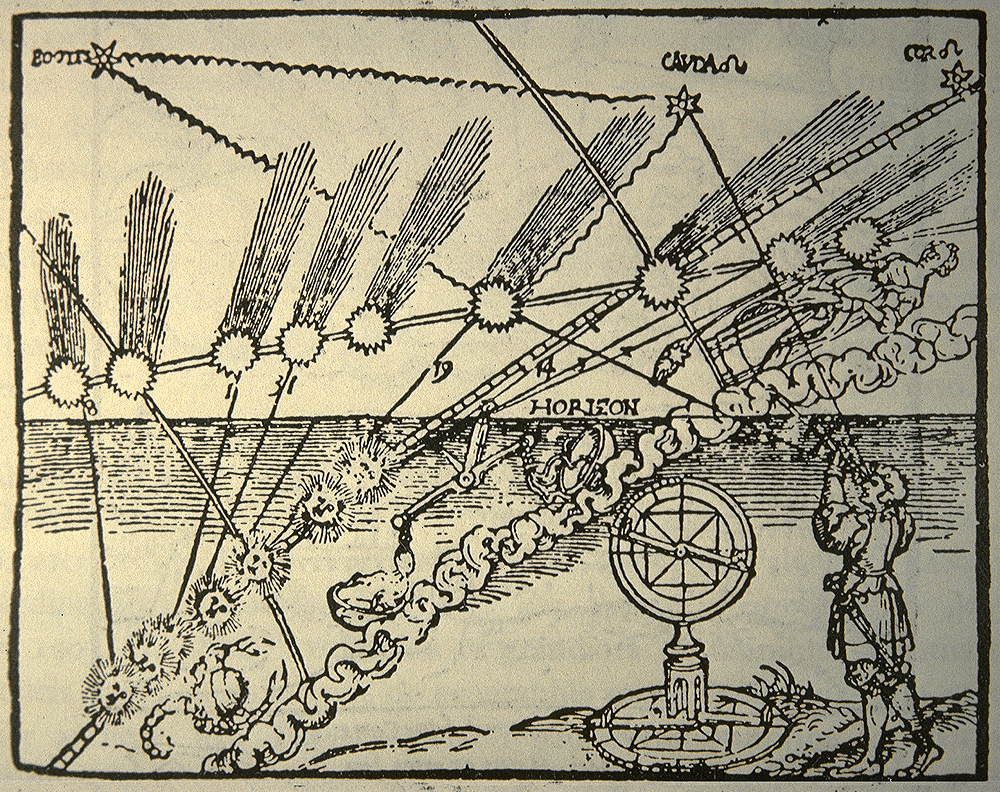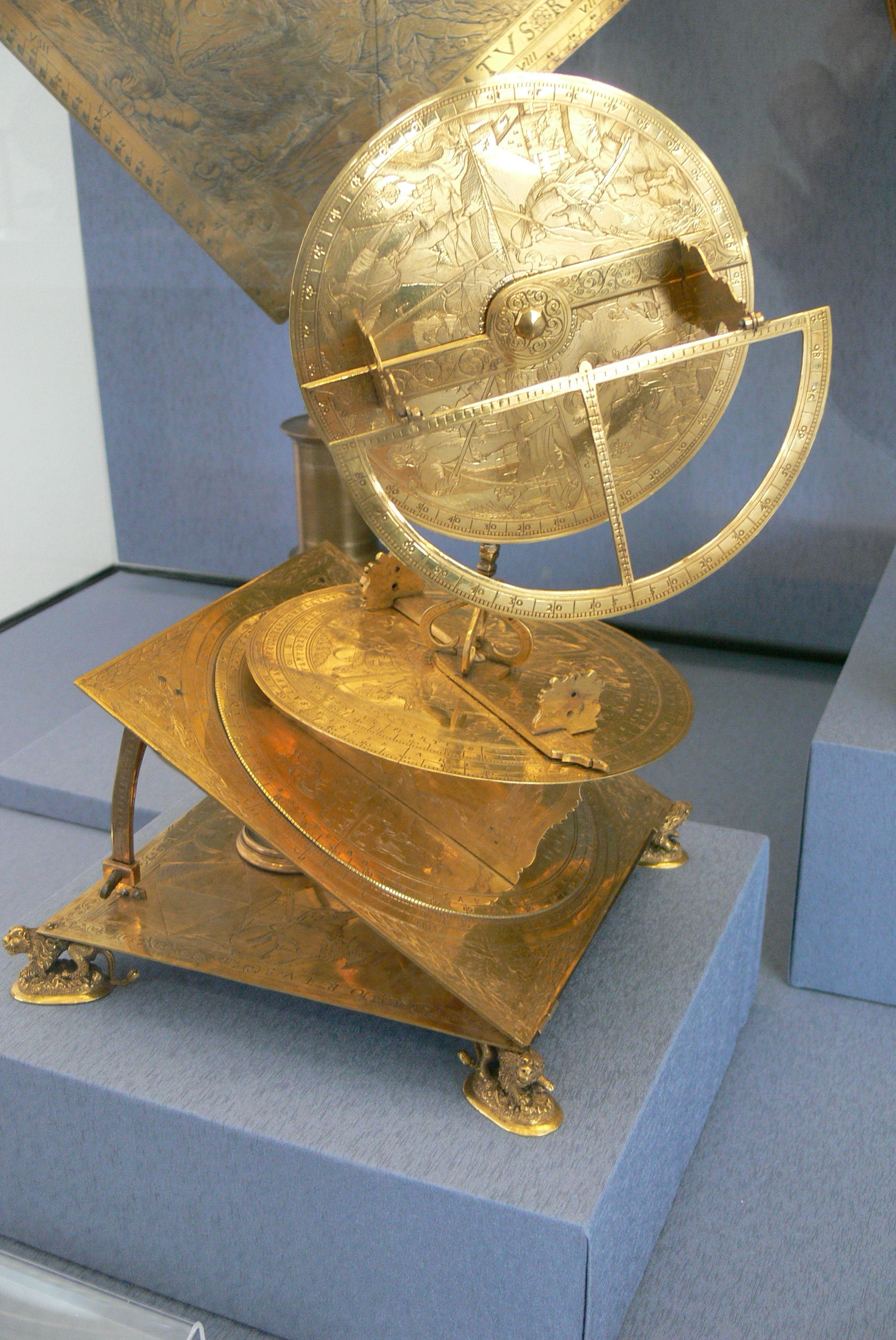|
Torquetum
The ''torquetum'' or turquet is a medieval astronomical instrument designed to take and convert measurements made in three sets of coordinates: Horizon, equatorial, and ecliptic. It is said to be a combination of Ptolemy's astrolabon and the plane astrolabe. In a sense, the ''torquetum'' is an analog computer. Invention The origins of the ''torquetum'' are unclear. The earliest account of the ''torquetum'' appear in the writings of Bernard of Verdun and Franco of Poland. Franco of Poland's work was published in 1284; however, Bernard of Verdun's work does not contain a date. Therefore, it is impossible to know which work was written first. Franco's work was more widely known and is credited with the distribution of knowledge about the ''torquetum''. The first ''torquetum'' is thought to have been built by Jabir ibn Aflah (more commonly known as Geber). However, there is conflicting evidence that suggests that Jabir simply inspired the invention of the torquetum. One of the re ... [...More Info...] [...Related Items...] OR: [Wikipedia] [Google] [Baidu] |
Jabir Ibn Aflah
Abū Muḥammad Jābir ibn Aflaḥ ( ar, أبو محمد جابر بن أفلح, la, Geber/Gebir; 1100–1150) was an Arab Muslim astronomer and mathematician from Seville, who was active in 12th century al-Andalus. His work ''Iṣlāḥ al-Majisṭi'' (Correction of the ''Almagest'') influenced Islamic, Jewish, and Christian astronomers. ''Iṣlāḥ al-Majisṭi (Correction of the Almagest)'' This work is a commentary and reworking of Ptolemy's ''Almagest'' and is the first criticism of it in the Islamic West. He particularly criticized the mathematical basis of the work. For example, he replaced the use of Menelaus' theorem with ones based on spherical trigonometry, in what seems to be an attempt to increase the mathematical precision of the work. These theorems had been developed by a group of 10th century Islamic mathematicians who included Abū al-Wafā' Būzjānī and then also by Abu Abd Allah Muhammad ibn Muadh Al-Jayyani who worked in Andalusia during the ... [...More Info...] [...Related Items...] OR: [Wikipedia] [Google] [Baidu] |
The Ambassadors (Holbein)
''The Ambassadors'' is a 1533 painting by Hans Holbein the Younger. Also known as ''Jean de Dinteville and Georges de Selve'', after the two people it portrays, it was created in the Tudor period, in the same year Elizabeth I was born. Franny Moyle speculates that Elizabeth's mother, Anne Boleyn, then Queen of England, might have commissioned the painting as a gift for Jean de Dinteville, the ambassador portrayed on the left in the painting. As well as being a double portrait, the painting contains a still life of several meticulously rendered objects, the meaning of which is the cause of much debate. It also incorporates one of the best-known examples of anamorphosis in painting. ''The Ambassadors'' has been part of London's National Gallery collection since its purchase in 1890. Description Although a German-born artist who spent much of his time in England, Holbein here displays the influence of Early Netherlandish painting. He used oils which for panel paintings had been d ... [...More Info...] [...Related Items...] OR: [Wikipedia] [Google] [Baidu] |
Astronomical Instruments
Astronomical instruments include: *Alidade *Armillary sphere * Astrarium *Astrolabe *Astronomical clock *the Antikythera mechanism, an astronomical clock *Blink comparator *Bolometer *the Canterbury Astrolabe Quadrant *Celatone *Celestial sphere *Charge-coupled device * Computers *CMOS sensor *Coronagraph * Cosmolabe *Dioptra * Equatorial ring * Equatorium *Gnomon *Inclinometer *Interferometer * Kamal *Meridian circle * Microchannel plate detector * Mural instrument * Nebra sky disk *Nocturnal * Octant *Optical spectrometer, a.k.a., Spectrograph *Orrery *Photographic plate *Photometer *Planisphere *the Prague astronomical clock * Quadrant *Reticle * Radio plate *Retroreflector * Scaphe *Sextant *Starshade *Space telescope *Spectrometers *Sundial *Telescope * Torquetum * Triquetrum *Zenith telescope See also *Astronomy * Outline of astronomy * Surveying instrument *Measurement instrument {{DEFAULTSORT:Astronomical instruments Instruments Instrument may refer to: Science a ... [...More Info...] [...Related Items...] OR: [Wikipedia] [Google] [Baidu] |
Declination
In astronomy, declination (abbreviated dec; symbol ''δ'') is one of the two angles that locate a point on the celestial sphere in the equatorial coordinate system, the other being hour angle. Declination's angle is measured north or south of the celestial equator, along the hour circle passing through the point in question. The root of the word ''declination'' (Latin, ''declinatio'') means "a bending away" or "a bending down". It comes from the same root as the words ''incline'' ("bend foward") and ''recline'' ("bend backward"). In some 18th and 19th century astronomical texts, declination is given as ''North Pole Distance'' (N.P.D.), which is equivalent to 90 – (declination). For instance an object marked as declination −5 would have an N.P.D. of 95, and a declination of −90 (the south celestial pole) would have an N.P.D. of 180. Explanation Declination in astronomy is comparable to geographic latitude, projected onto the celestial sphere, and right ascension is ... [...More Info...] [...Related Items...] OR: [Wikipedia] [Google] [Baidu] |
Right Ascension
Right ascension (abbreviated RA; symbol ) is the angular distance of a particular point measured eastward along the celestial equator from the Sun at the March equinox to the ( hour circle of the) point in question above the earth. When paired with declination, these astronomical coordinates specify the location of a point on the celestial sphere in the equatorial coordinate system. An old term, ''right ascension'' ( la, ascensio recta), "''Ascensio recta'' Solis, stellæ, aut alterius cujusdam signi, est gradus æquatorus cum quo simul exoritur in sphæra recta"; roughly translated, "''Right ascension'' of the Sun, stars, or any other sign, is the degree of the equator that rises together in a right sphere" refers to the ''ascension'', or the point on the celestial equator that rises with any celestial object as seen from Earth's equator, where the celestial equator intersects the horizon at a right angle. It contrasts with ''oblique ascension'', the point on the ce ... [...More Info...] [...Related Items...] OR: [Wikipedia] [Google] [Baidu] |
Analog Computer
An analog computer or analogue computer is a type of computer that uses the continuous variation aspect of physical phenomena such as electrical, mechanical, or hydraulic quantities (''analog signals'') to model the problem being solved. In contrast, digital computers represent varying quantities symbolically and by discrete values of both time and amplitude ( digital signals). Analog computers can have a very wide range of complexity. Slide rules and nomograms are the simplest, while naval gunfire control computers and large hybrid digital/analog computers were among the most complicated. Complex mechanisms for process control and protective relays used analog computation to perform control and protective functions. Analog computers were widely used in scientific and industrial applications even after the advent of digital computers, because at the time they were typically much faster, but they started to become obsolete as early as the 1950s and 1960s, although they ... [...More Info...] [...Related Items...] OR: [Wikipedia] [Google] [Baidu] |
List Of Astronomical Instruments
Astronomical instruments include: *Alidade *Armillary sphere * Astrarium *Astrolabe * Astronomical clock *the Antikythera mechanism, an astronomical clock *Blink comparator *Bolometer *the Canterbury Astrolabe Quadrant * Celatone *Celestial sphere *Charge-coupled device * Computers *CMOS sensor *Coronagraph * Cosmolabe *Dioptra * Equatorial ring * Equatorium *Gnomon *Inclinometer *Interferometer * Kamal *Meridian circle * Microchannel plate detector * Mural instrument * Nebra sky disk *Nocturnal * Octant *Optical spectrometer, a.k.a., Spectrograph *Orrery *Photographic plate *Photometer *Planisphere *the Prague astronomical clock * Quadrant *Reticle * Radio plate *Retroreflector * Scaphe *Sextant *Starshade *Space telescope *Spectrometers *Sundial *Telescope * Torquetum * Triquetrum *Zenith telescope See also *Astronomy * Outline of astronomy * Surveying instrument *Measurement instrument {{DEFAULTSORT:Astronomical instruments Instruments Instrument may refer to: Science ... [...More Info...] [...Related Items...] OR: [Wikipedia] [Google] [Baidu] |
Peter Of Limoges
Peter of Limoges ( la, Petrus Lemovicensis or '; french: Pierre de Limoges; – 1306) was the author of ''A Moral Treatise on the Eye'' ( la, Tractatus Moralis de Oculo) or ''On the Moral Eye'' ('), a popular guide for Catholic priests, composed at the University of Paris sometime in the 1270s or '80s. The work depended heavily on Roger Bacon's earlier treatment of optics. Peter of Limoges was the friend of Robert de Sorbonne and also taught at the University of Sorbonne. He was a disciple of Ramon Llull.Anthony Bonner (ed.), ''Doctor illuminatus: A Ramon Llull Reader'', Princeton University Press, 1993, p. 82. He may be identical to the Peter of Limoges who was the first known dean of the faculty of medicine at the University of Paris The University of Paris (french: link=no, Université de Paris), Metonymy, metonymically known as the Sorbonne (), was the leading university in Paris, France, active from 1150 to 1970, with the exception between 1793 and 1806 under the Frenc ... [...More Info...] [...Related Items...] OR: [Wikipedia] [Google] [Baidu] |
Historical Scientific Instruments
History (derived ) is the systematic study and the documentation of the human activity. The time period of event before the invention of writing systems is considered prehistory. "History" is an umbrella term comprising past events as well as the memory, discovery, collection, organization, presentation, and interpretation of these events. Historians seek knowledge of the past using historical sources such as written documents, oral accounts, art and material artifacts, and ecological markers. History is not complete and still has debatable mysteries. History is also an academic discipline which uses narrative to describe, examine, question, and analyze past events, and investigate their patterns of cause and effect. Historians often debate which narrative best explains an event, as well as the significance of different causes and effects. Historians also debate the nature of history as an end in itself, as well as its usefulness to give perspective on the problems o ... [...More Info...] [...Related Items...] OR: [Wikipedia] [Google] [Baidu] |
Navigational Equipment
Navigation is a field of study that focuses on the process of monitoring and controlling the movement of a craft or vehicle from one place to another.Bowditch, 2003:799. The field of navigation includes four general categories: land navigation, marine navigation, aeronautic navigation, and space navigation. It is also the term of art used for the specialized knowledge used by navigators to perform navigation tasks. All navigational techniques involve locating the navigator's position compared to known locations or patterns. Navigation, in a broader sense, can refer to any skill or study that involves the determination of position and direction. In this sense, navigation includes orienteering and pedestrian navigation. History In the European medieval period, navigation was considered part of the set of '' seven mechanical arts'', none of which were used for long voyages across open ocean. Polynesian navigation is probably the earliest form of open-ocean navigation; it was b ... [...More Info...] [...Related Items...] OR: [Wikipedia] [Google] [Baidu] |
Astrolabe
An astrolabe ( grc, ἀστρολάβος ; ar, ٱلأَسْطُرلاب ; persian, ستارهیاب ) is an ancient astronomical instrument that was a handheld model of the universe. Its various functions also make it an elaborate inclinometer and an analog calculation device capable of working out several kinds of problems in astronomy. In its simplest form it is a metal disc with a pattern of wires, cutouts, and perforations that allows a user to calculate astronomical positions precisely. Historically used by astronomers, it is able to measure the altitude above the horizon of a celestial body, day or night; it can be used to identify stars or planets, to determine local latitude given local time (and vice versa), to survey, or to triangulate. It was used in classical antiquity, the Islamic Golden Age, the European Middle Ages and the Age of Discovery for all these purposes. The astrolabe's importance comes not only from the early developments into the study of ast ... [...More Info...] [...Related Items...] OR: [Wikipedia] [Google] [Baidu] |






.jpg)
